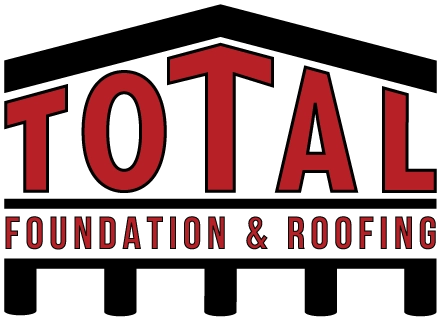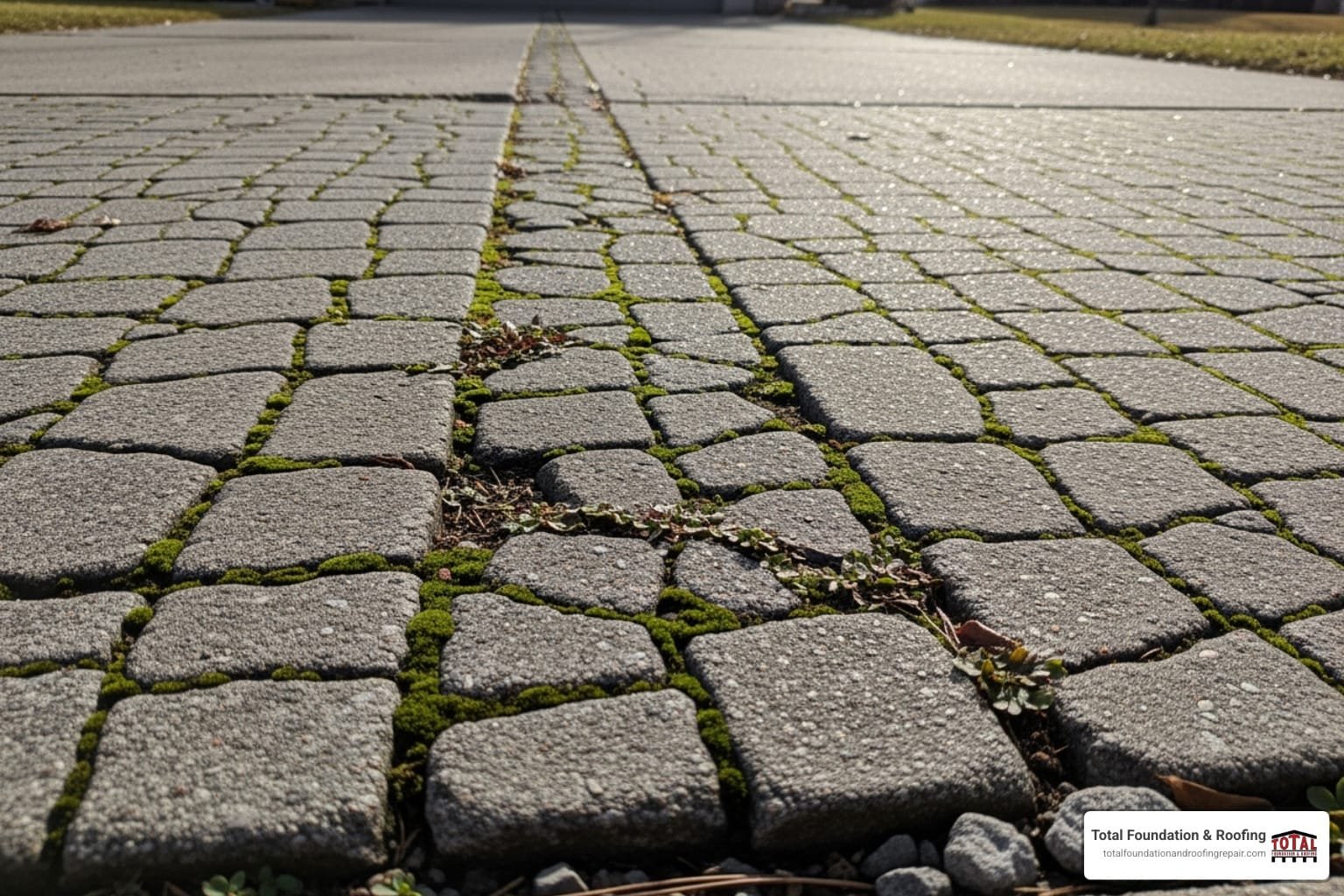Table of Contents
ToggleThe Unseen Threat: Understanding Expansive Soil
Expansive soil foundation problems are a pervasive issue affecting countless homeowners, especially across Texas. This clay-rich soil, often containing minerals like montmorillonite, has a unique capacity to absorb water, causing it to swell dramatically. When it dries, it shrinks and hardens, creating a destructive cycle that can crack foundations and lead to extensive, costly repairs. For many Texans, protecting your home begins with understanding the volatile ground it’s built on. Causing billions in damages nationwide each year, these soils can exert immense pressure on a foundation, sometimes as much as 5,500 pounds per square foot.
The constant shrink-swell cycle puts tremendous, uneven stress on rigid concrete structures. This leads to differential settlement—a condition where different parts of your home sink or heave at different rates, compromising its structural integrity. Be vigilant for these common warning signs:
- Cracks in Walls: Look for jagged, diagonal, or stair-step cracks in drywall and plaster, particularly radiating from the corners of doors and windows.
- Sticking Doors and Windows: When a foundation shifts, it can warp the frames of doors and windows, causing them to bind, stick, or fail to latch properly.
- Uneven or Sloping Floors: A floor that feels bouncy, looks visibly sloped, or allows a marble to roll to one side of the room is a classic indicator of foundation movement.
- Exterior Cracks: Significant cracks in exterior brickwork, stucco, or the foundation slab itself are direct evidence of stress.
- Leaning Chimneys or Porches: A chimney or porch that is pulling away from the main structure is a serious red flag for severe differential settlement.
Understanding this challenge is the first step toward a solution. I’m Daniel Sowell, owner of Total Foundation & Roofing Repair, and for over 18 years, I’ve helped Texas Hill Country homeowners diagnose and resolve expansive soil foundation issues. Early detection and professional foundation repair solutions are crucial to prevent minor issues from escalating into major structural failures.

What is Expansive Soil and How Does it Damage Foundations?
Imagine your home resting on millions of microscopic sponges that swell with every rain and shrink during every dry spell. That’s an expansive soil foundation. These soils are rich in specific clay minerals, primarily from the smectite group like montmorillonite, which have a crystalline structure that allows them to absorb vast quantities of water. This absorption causes the soil volume to increase, creating immense upward pressure, or “heaving,” against the foundation. Conversely, when the soil dries out, it shrinks, creating voids beneath the foundation. This loss of support causes parts of your home to sink, or “settle.”
This relentless cycle of heaving and settling is rarely uniform across the entire foundation. This uneven, or “differential,” movement is what truly compromises your home’s structure. This destructive dance between soil and structure is why expansive soils are responsible for more property damage than many other natural hazards combined, as detailed in scientific research on expansive soil.
Telltale Signs of Foundation Damage
Your home will often signal when its foundation is in trouble. Catching these signs early can save you significant expense and stress. One of the most common indicators is the appearance of substantial cracks.
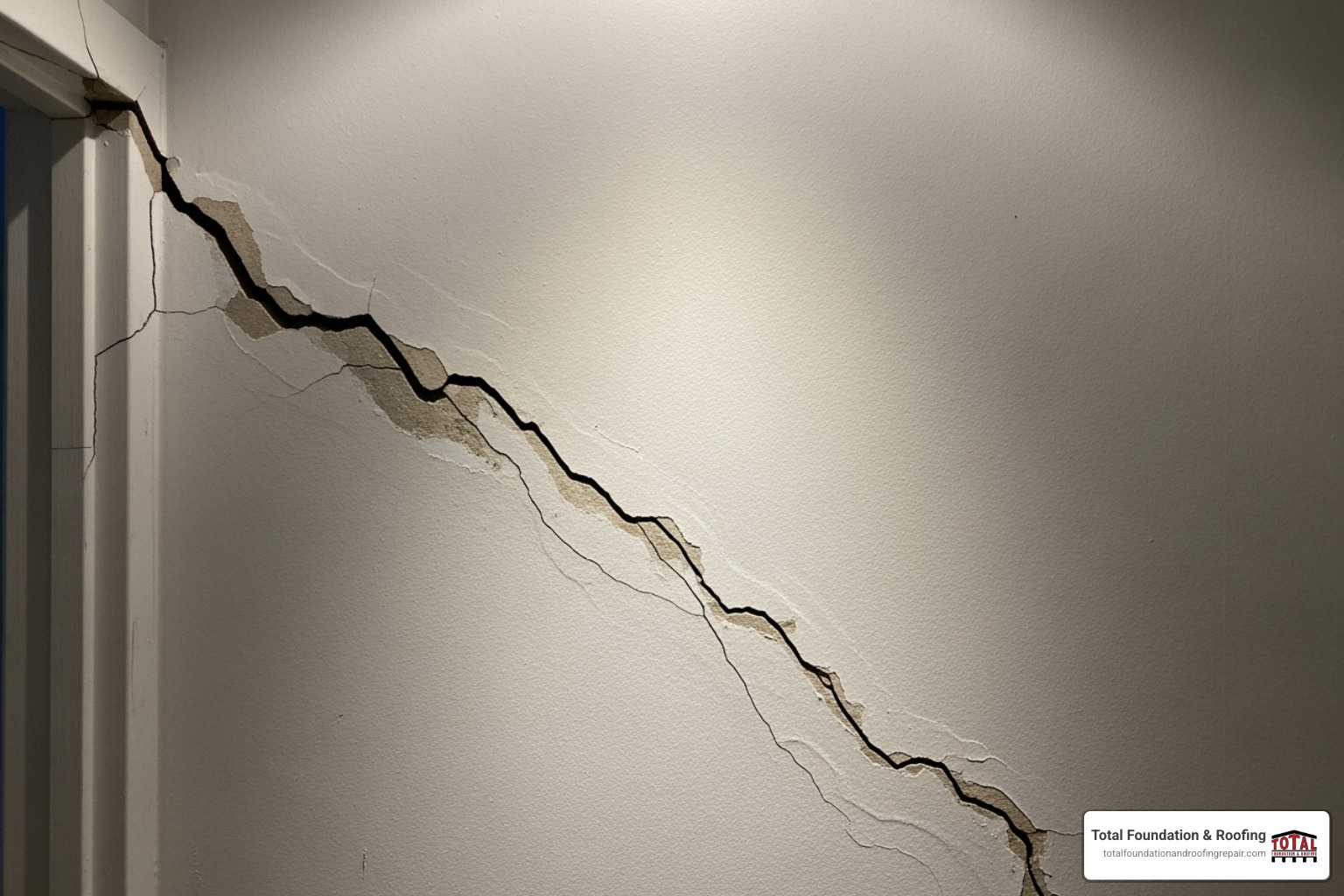
Here are the most common signs of foundation trouble we see in the Texas Hill Country:
- Wall Cracks: Look for diagonal or stair-step cracks in drywall, plaster, or exterior brick.
- Floor Cracks: Noticeable cracks in concrete slab floors or tile grout can indicate movement.
- Sticking Doors and Windows: If doors or windows suddenly bind or won’t close properly, their frames may be distorted from foundation shifts.
- Leaning Chimneys: A chimney pulling away from the house is a serious red flag for differential settlement.
- Uneven Floors: A sloping feeling or a marble rolling to one side of a room indicates uneven settling or heaving.
- Cabinet Gaps: Gaps forming between kitchen or bathroom cabinets and the wall are a subtle sign of movement.
If you see a combination of these signs, it’s highly likely you’re dealing with an expansive soil foundation problem.
How to Identify Expansive Soil on Your Property
How do you know if you have expansive soil? During dry spells, look for large, deep cracks in your yard, often in a polygonal pattern. The soil may pull away from your foundation, creating a visible gap. When wet, the soil will feel very sticky and dense, like modeling clay. While a professional geotechnical report provides a definitive answer, these signs, combined with the foundation damage symptoms listed above, are strong indicators. If you’re concerned, it’s always best to consult with professionals who can assess your property’s specific soil challenges.
Protecting Your Home: Prevention and Repair for an Expansive Soil Foundation
When dealing with an expansive soil foundation, you are not powerless. Smart prevention strategies and proven repair methods can protect your home. The key to reliable foundation solutions in the Texas Hill Country is managing moisture consistently.
Proactive Prevention: The Power of Moisture Control
Expansive soil foundation problems are almost always about water—too much causes swelling, and too little causes shrinkage. The goal is to keep moisture levels around your foundation as stable as possible year-round.
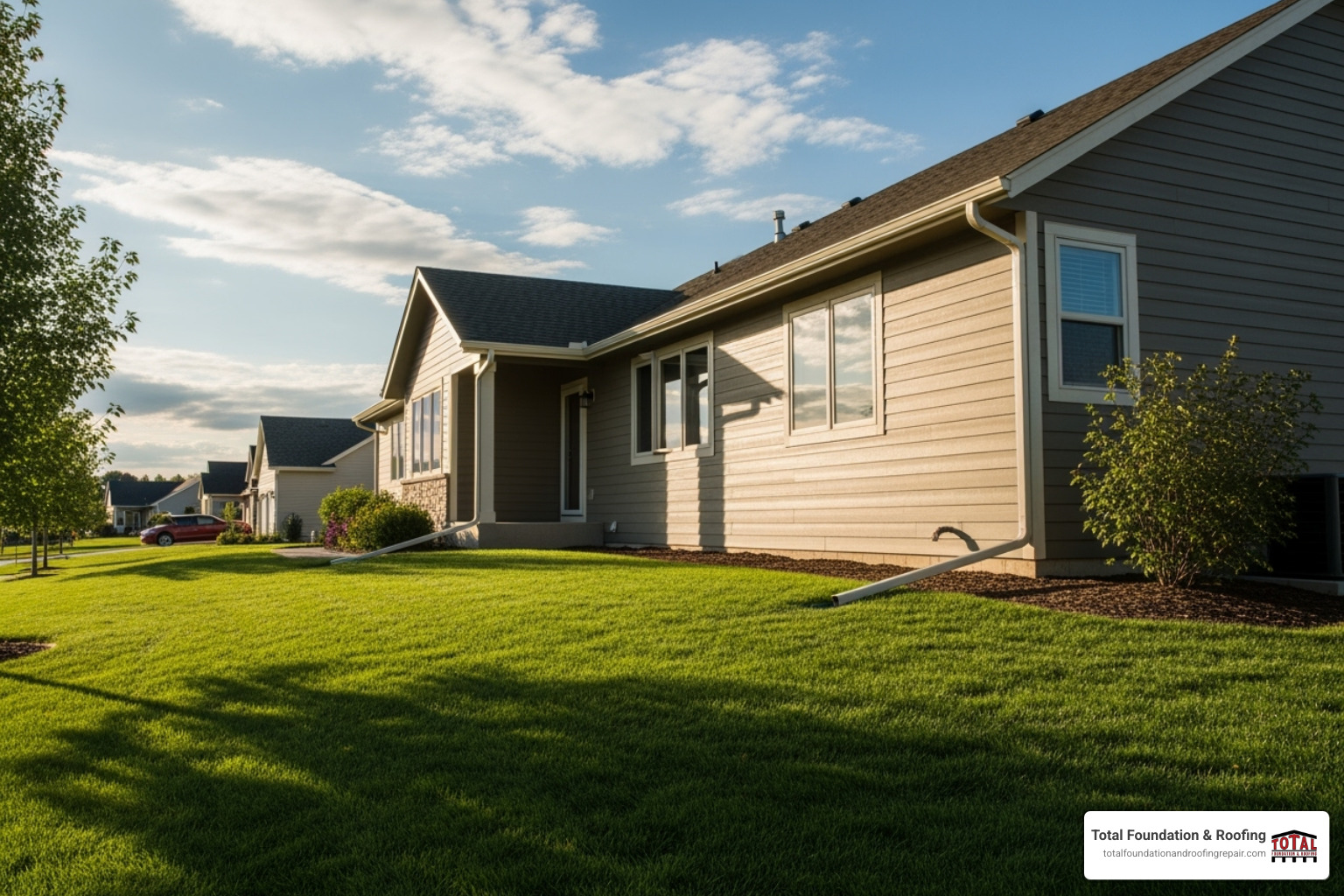
- Gutters and Downspouts: Keep gutters clean and ensure downspouts discharge water at least four to six feet away from the foundation, using extensions if necessary.
- Proper Yard Grading: The ground should slope away from your home (about six inches of fall for every ten feet) to direct surface water away from the foundation perimeter.
- French Drains: These underground trenches, filled with gravel and a perforated pipe, collect and redirect excess groundwater before it can saturate the soil near your foundation.
- Sump Pumps: In basements or crawl spaces, sump pumps are essential for actively removing water that accumulates against foundation walls, preventing hydrostatic pressure buildup.
- Foundation Waterproofing: Applying a waterproof membrane or sealant to your foundation is like giving it a raincoat, preventing moisture intrusion. Our Foundation Waterproofing services can create this vital barrier.
- Smart Landscaping: Plant large trees at least ten feet from your foundation, as their roots can draw significant moisture from the soil, causing it to shrink. For flower beds near the house, use drip irrigation or soaker hoses to deliver water directly to plants without oversaturating the surrounding soil.
- Consistent Watering: During prolonged dry periods, a foundation watering program using soaker hoses placed around the perimeter can help maintain a more consistent moisture level in the soil, preventing excessive shrinkage and settlement.
Building and Repairing on an Expansive Soil Foundation
When prevention isn’t enough, or for homes already experiencing damage, specialized construction and repair methods are necessary to create a stable, long-term solution.
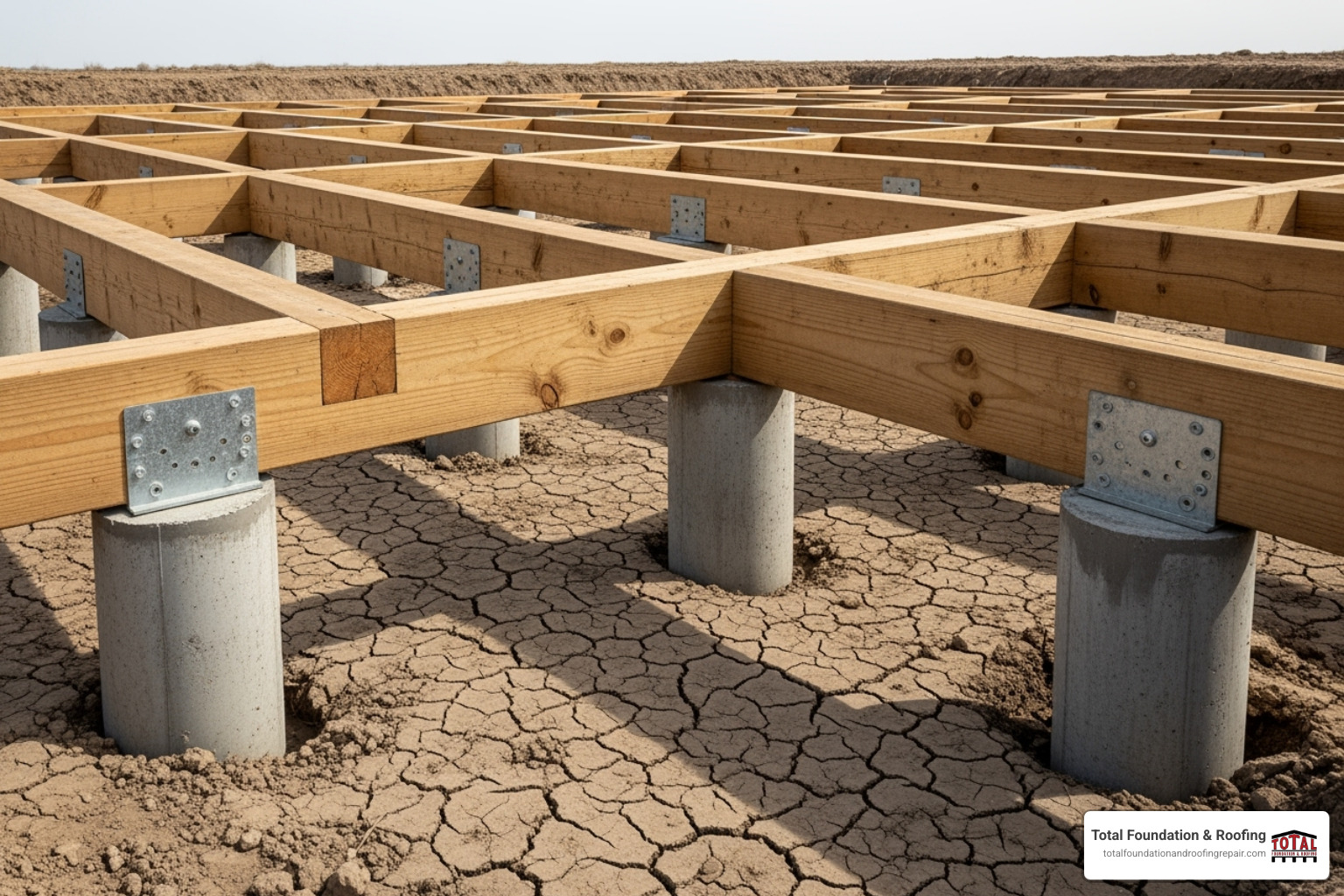
For new construction, pier and beam foundations are an excellent choice, as they lift the home on piers drilled into stable soil, bypassing the volatile clay layer. For existing foundations, repairs often involve installing piers to provide new, reliable support.
Underpinning with steel piers is a highly effective repair method. This process involves hydraulically driving interlocking steel pipe sections deep into the ground until they reach a stable soil layer or bedrock. Brackets are then attached to the foundation, and the load of the house is transferred to the piers. This not only stabilizes the foundation but can sometimes be used to lift settled sections back toward their original level. Our expertise in House Leveling ensures these complex repairs are done correctly and safely.
| Foundation Type | Description | Pros for Expansive Soil | Cons for Expansive Soil |
|---|---|---|---|
| Slab-on-Grade | Concrete slab poured directly on prepared ground | Relatively inexpensive, quick to build | Highly vulnerable to soil movement, cracking, heaving |
| Pier and Beam | Home supported by deep piers and beams with crawl space | Isolates home from soil movement, allows access to utilities | Higher initial cost, requires proper moisture control |
| Waffle Mat | Thick slab with grid of voids underneath | Voids accommodate soil expansion, very strong | More concrete needed, specialized construction |
| Drilled Pier Repair | Concrete piers extended to stable soil | Provides deep, permanent support | Can be invasive, cost depends on required depth |
| Steel Pier Underpinning | Steel pipes driven to bedrock or stable soil | Highly effective, can lift existing foundations | Requires specialized equipment, variable costs |
Navigating Repairs and Insurance Coverage
Unfortunately, most standard homeowner’s insurance policies do not cover damage from the natural shrink-swell cycle of expansive soil. This is typically excluded under clauses for “earth movement” or “settlement,” which are intended to protect insurers from widespread, gradual geological events. Coverage might apply only if the damage is a direct and sudden result of a covered peril, like a burst pipe that causes a specific area of soil to become saturated and heave. In such cases, you would need to prove the pipe burst was the proximate cause of the damage.
Always review your policy carefully and talk to your agent to understand your specific coverage and exclusions. Since insurance rarely helps, prevention and timely repairs are even more critical. Understanding potential expenses, like the Foundation Crack Repair Cost, can help you budget for necessary maintenance.
When repairs are needed, work with experienced professionals. Expansive soil foundation problems require specialized knowledge, as detailed in resources covering special building methods for expansive soils. A reputable company will diagnose the root cause and recommend a lasting solution tailored to your property.
Secure Your Home’s Future in the Texas Hill Country
Living in the beautiful Texas Hill Country comes with the reality of expansive soil foundation challenges. The good news is that you don’t have to face them alone. With a proactive approach and professional guidance, your home can remain a solid, secure haven.
Long-term stability depends on understanding your property’s unique soil, drainage, and foundation needs. When repairs are necessary, professional expertise is non-negotiable. As experts in foundation repair in Kerrville, TX, and across the Hill Country, we understand the local conditions that put stress on your home, from summer droughts to flash floods.
Your home is your most significant investment and the center of your family’s life. Protecting its foundation is a responsibility we take seriously.
If you see signs of trouble—like a small crack or a sticking door—don’t wait for the problem to worsen. These are your home’s early warning signals. Addressing them now can save you thousands of dollars and significant disruption later.
Request a Free Estimate today to secure your home’s foundation. Let us help you protect your investment so you can enjoy life in one of Texas’s most beautiful regions, worry-free.
